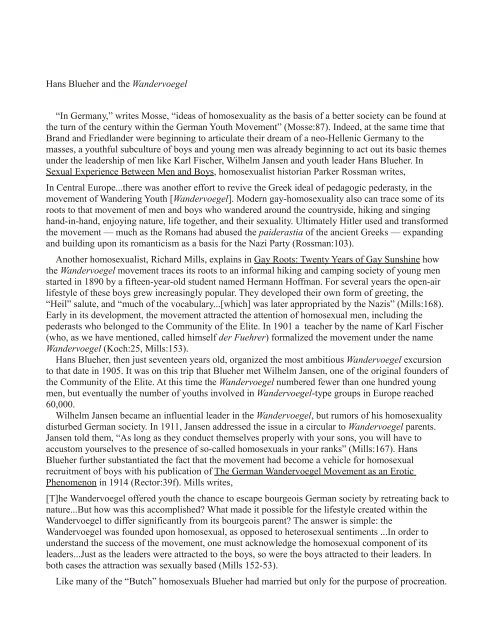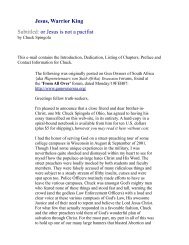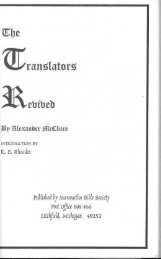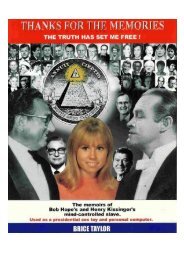THE PINK SWASTIKA - Shattering Denial
THE PINK SWASTIKA - Shattering Denial
THE PINK SWASTIKA - Shattering Denial
Create successful ePaper yourself
Turn your PDF publications into a flip-book with our unique Google optimized e-Paper software.
Hans Blueher and the Wandervoegel<br />
“In Germany,” writes Mosse, “ideas of homosexuality as the basis of a better society can be found at<br />
the turn of the century within the German Youth Movement” (Mosse:87). Indeed, at the same time that<br />
Brand and Friedlander were beginning to articulate their dream of a neo-Hellenic Germany to the<br />
masses, a youthful subculture of boys and young men was already beginning to act out its basic themes<br />
under the leadership of men like Karl Fischer, Wilhelm Jansen and youth leader Hans Blueher. In<br />
Sexual Experience Between Men and Boys, homosexualist historian Parker Rossman writes,<br />
In Central Europe...there was another effort to revive the Greek ideal of pedagogic pederasty, in the<br />
movement of Wandering Youth [Wandervoegel]. Modern gay-homosexuality also can trace some of its<br />
roots to that movement of men and boys who wandered around the countryside, hiking and singing<br />
hand-in-hand, enjoying nature, life together, and their sexuality. Ultimately Hitler used and transformed<br />
the movement — much as the Romans had abused the paiderastia of the ancient Greeks — expanding<br />
and building upon its romanticism as a basis for the Nazi Party (Rossman:103).<br />
Another homosexualist, Richard Mills, explains in Gay Roots: Twenty Years of Gay Sunshine how<br />
the Wandervoegel movement traces its roots to an informal hiking and camping society of young men<br />
started in 1890 by a fifteen-year-old student named Hermann Hoffman. For several years the open-air<br />
lifestyle of these boys grew increasingly popular. They developed their own form of greeting, the<br />
“Heil” salute, and “much of the vocabulary...[which] was later appropriated by the Nazis” (Mills:168).<br />
Early in its development, the movement attracted the attention of homosexual men, including the<br />
pederasts who belonged to the Community of the Elite. In 1901 a teacher by the name of Karl Fischer<br />
(who, as we have mentioned, called himself der Fuehrer) formalized the movement under the name<br />
Wandervoegel (Koch:25, Mills:153).<br />
Hans Blueher, then just seventeen years old, organized the most ambitious Wandervoegel excursion<br />
to that date in 1905. It was on this trip that Blueher met Wilhelm Jansen, one of the original founders of<br />
the Community of the Elite. At this time the Wandervoegel numbered fewer than one hundred young<br />
men, but eventually the number of youths involved in Wandervoegel-type groups in Europe reached<br />
60,000.<br />
Wilhelm Jansen became an influential leader in the Wandervoegel, but rumors of his homosexuality<br />
disturbed German society. In 1911, Jansen addressed the issue in a circular to Wandervoegel parents.<br />
Jansen told them, “As long as they conduct themselves properly with your sons, you will have to<br />
accustom yourselves to the presence of so-called homosexuals in your ranks” (Mills:167). Hans<br />
Blueher further substantiated the fact that the movement had become a vehicle for homosexual<br />
recruitment of boys with his publication of The German Wandervoegel Movement as an Erotic<br />
Phenomenon in 1914 (Rector:39f). Mills writes,<br />
[T]he Wandervoegel offered youth the chance to escape bourgeois German society by retreating back to<br />
nature...But how was this accomplished? What made it possible for the lifestyle created within the<br />
Wandervoegel to differ significantly from its bourgeois parent? The answer is simple: the<br />
Wandervoegel was founded upon homosexual, as opposed to heterosexual sentiments ...In order to<br />
understand the success of the movement, one must acknowledge the homosexual component of its<br />
leaders...Just as the leaders were attracted to the boys, so were the boys attracted to their leaders. In<br />
both cases the attraction was sexually based (Mills 152-53).<br />
Like many of the “Butch” homosexuals Blueher had married but only for the purpose of procreation.









